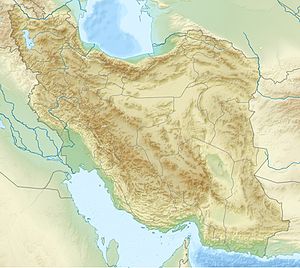Hormuz (island)
| Hormuz | ||
|---|---|---|
| Chezr Bay | ||
| Waters | Persian Gulf | |
| Geographical location | 27 ° 4 ′ 0 ″ N , 56 ° 27 ′ 0 ″ E | |
|
|
||
| length | 7 km | |
| width | 7.6 km | |
| surface | 42 km² | |
| Highest elevation | 186 m | |
| Residents | 3000 71 inhabitants / km² |
|
| main place | Hormuz | |
Hormuz ( Persian هرمز Hormoz , older also Ormuz ) is abare rock island in the Persian Gulf belongingto Iran and is located 18 kilometers east of the island of Qeschm in the Strait of Hormuz .
geography
Hormuz is located 16 kilometers south of the Iranian coast (near Bandar Abbas ) and is almost circular. The surface of the island is about 42 square kilometers and consists mainly of sedimentary rocks . Its highest point is 186 meters above sea level. Hormuz has neither fresh water nor vegetation worth mentioning.
history
The island was known as Organa in ancient times and as Jarun in the Islamic era . Hormuz, on the other hand, was originally the name of the important port city on the mainland northeast of the island (not far from today's Minab ), which formed the center of a principality and was visited by Marco Polo in 1272 and 1293 . Shortly afterwards (around 1315), Hormuz's ruler, the Emir Baha ad-Din Ayaz, decided to move his residence to the safe island due to Mongol campaigns on the coast. A new city was founded here, which was known for a long time as New Hormuz in contrast to Old Hormuz on the mainland, until it fell into disrepair. Over time, the name of the old town became the name for the whole island.
As the center of the principality, the new Hormuz was a difficult location on the island as all supplies including drinking water had to be brought from the mainland. In the area around the strait, which has been repeatedly affected by many wars, however, its safe location proved to be favorable, so that an important trading center was created which, due to the repeated destruction of its competitors, could flourish for several centuries.
Under the rule of the Portuguese (with interruptions from 1515 to 1622), the city of Hormuz on the north coast of the island was one of the most important trading centers on the Arabian Sea and one of the richest trading cities on earth. At that time, up to 40,000 people lived on Hormuz. The English navigator William Baffin died on Hormuz in 1622 . After the island was taken by the Persian Shah Abbas the Great with the help of six English warships, the commercial center fell into disrepair and the importance of Hormuz declined significantly. Rock salt and iron ore (as ballast rock for the sailing ships) were mined. Apart from the fishermen, most of its residents were drawn to the fields and groves on the coast near the former old city of Hormuz.
Today around 3,000 people live on Hormuz.
Attractions
An old Portuguese fort dates from the era of Portuguese rule , the only remaining sight on the island.
Economy and Infrastructure
Almost all aspects of Hormuz are supplied from the mainland as there is no drinking water on the island. Important sources of income are the smuggling of cigarettes into the United Arab Emirates and the mining of the island's red iron stone , which is important for the pharmaceutical industry .
- photos
Ocher art on the island's beaches
Cliff coast or rocky cliff of the island







